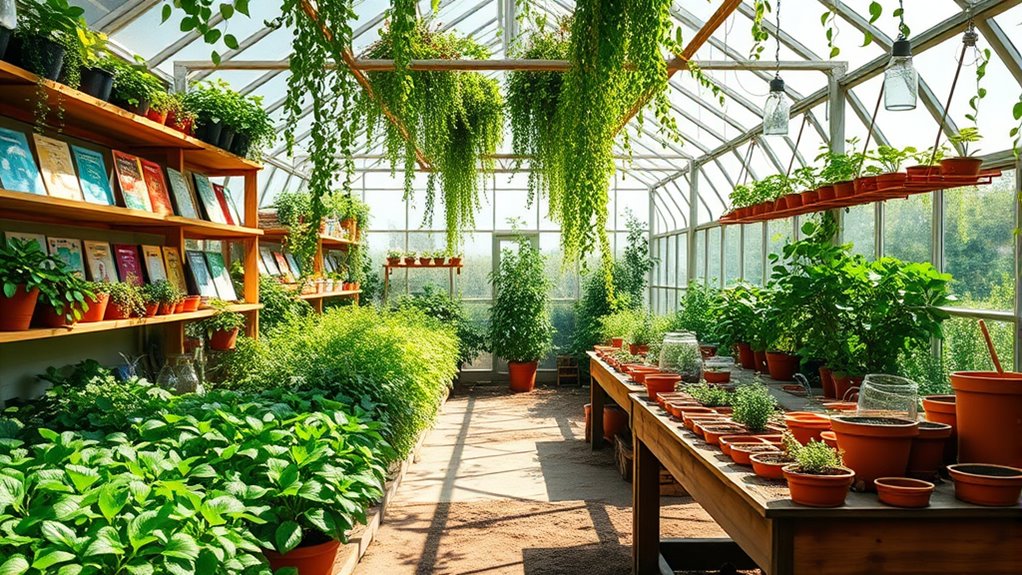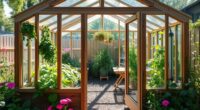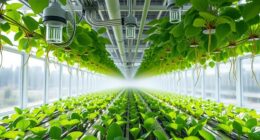To organize your greenhouse for efficiency, start by assessing your layout and optimizing plant placement based on their needs. Implement vertical growing techniques like trellises to maximize space and ensure easy access for maintenance. Automate climate control and material handling to save time and reduce costs. Establish efficient water management practices and monitor energy usage. These steps can significantly enhance your productivity, and there's more to explore for maximizing your greenhouse's potential.
Key Takeaways
- Group plants with similar needs to streamline care and optimize space in your greenhouse.
- Utilize vertical space with shelves, trellises, and hanging baskets for increased growing capacity.
- Implement automated irrigation and environmental control systems to ensure precise care and reduce manual labor.
- Maintain clear pathways and organized storage to improve workflow and accessibility in the greenhouse.
- Regularly assess and adjust climate control measures to enhance energy efficiency and plant growth conditions.
Assessing Your Current Greenhouse Layout

When assessing your current greenhouse layout, start by evaluating five key factors: orientation, space utilization, environmental controls, plant placement, and structural integrity.
First, ensure your greenhouse has optimal solar access for photosynthesis and consider wind protection through shelter belts.
Next, measure the greenhouse size to maximize space usage by minimizing pathway widths and using adjustable shelving. Efficient pathways will help facilitate easy movement throughout the greenhouse.
Analyze your environmental controls by ensuring uniform heating and air circulation to prevent plant stress.
For plant placement, group plants with similar needs and utilize vertical gardening techniques for better space efficiency.
Lastly, review structural integrity by choosing durable materials and ensuring good drainage at the site.
Addressing these areas will enhance your greenhouse's functionality and productivity.
Implementing Efficient Material Handling Processes
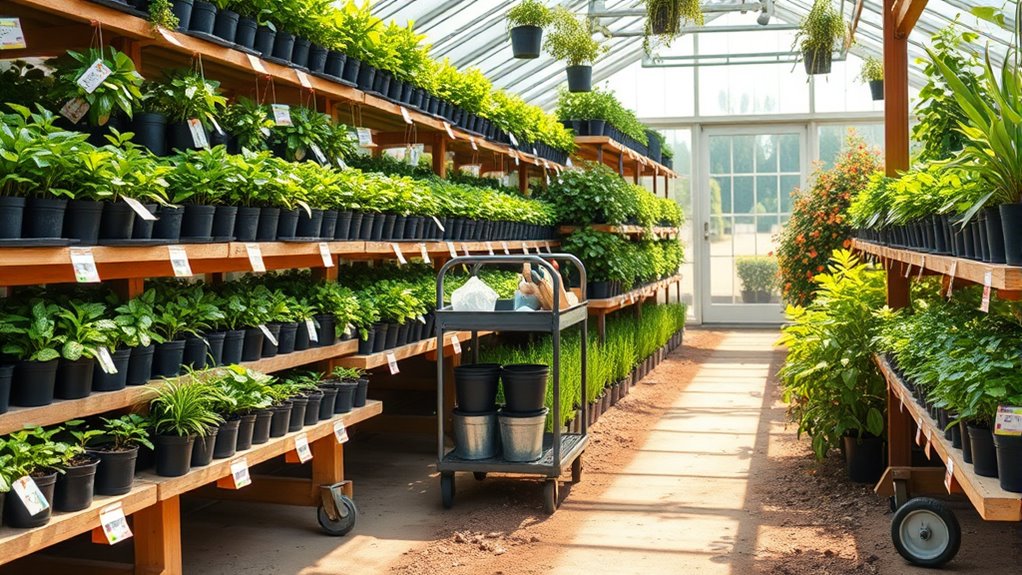
To boost productivity in your greenhouse, implementing efficient material handling processes is essential. Start by investing in material handling equipment like conveyors, carts, and forklifts. These tools can automate repetitive tasks, reducing labor costs significantly.
Design your layout for flow optimization, ensuring smooth movement of materials from input to output, which minimizes congestion. Regularly maintain your equipment to keep it performing at its best. Consider mechanization and automation tools, such as pot dispensers, to enhance efficiency, especially during peak seasons. Evaluate equipment costs against potential long-term savings to make informed decisions.
Lastly, ensure adequate aisle space and organize your storage for quick access to supplies, which will streamline operations and help your team work more effectively.
Choosing the Right Greenhouse Structure and Covering
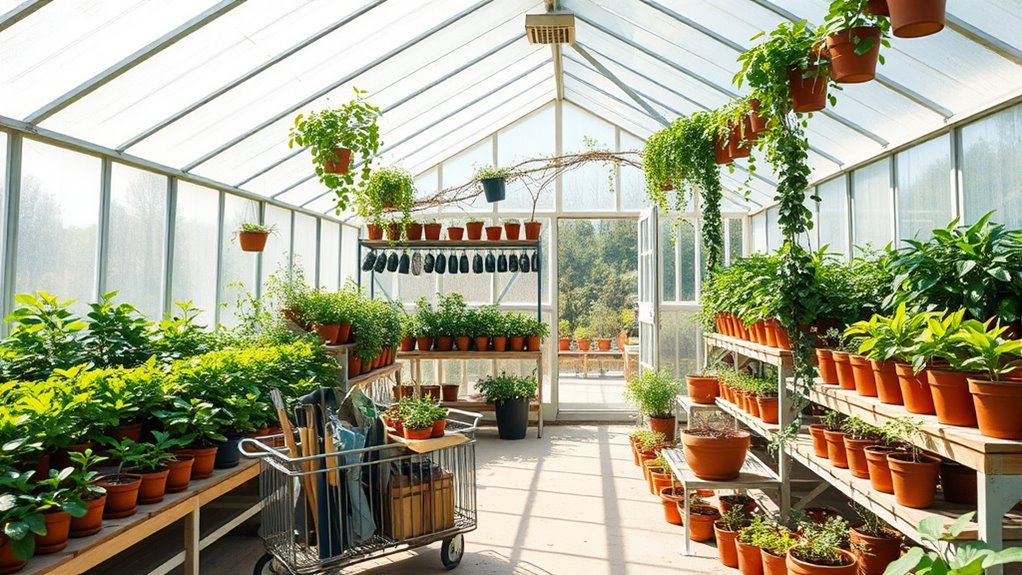
Choosing the right greenhouse structure and covering can significantly impact your growing success. Start by considering your operation size and specific needs. High tunnels work well for larger setups, while low tunnels are perfect for smaller, microclimate-focused gardens.
For frost protection, hoop houses are ideal. If you want a controlled environment, traditional or commercial greenhouses are your best bets. Commercial greenhouses often employ advanced technology for controlled environments, which can further enhance productivity.
Next, select an appropriate frame type. Gothic frames provide strength against snow and wind, but Quonset frames are economical and easy to assemble.
Select a frame type wisely: Gothic frames offer durability against harsh weather, while Quonset frames are budget-friendly and simple to construct.
When it comes to covering, polycarbonate plastic is durable and long-lasting, while glass offers excellent light transmission.
Don't forget about climate considerations and plant requirements to maximize your efficiency and productivity.
Maximizing Space With Vertical Growing Techniques
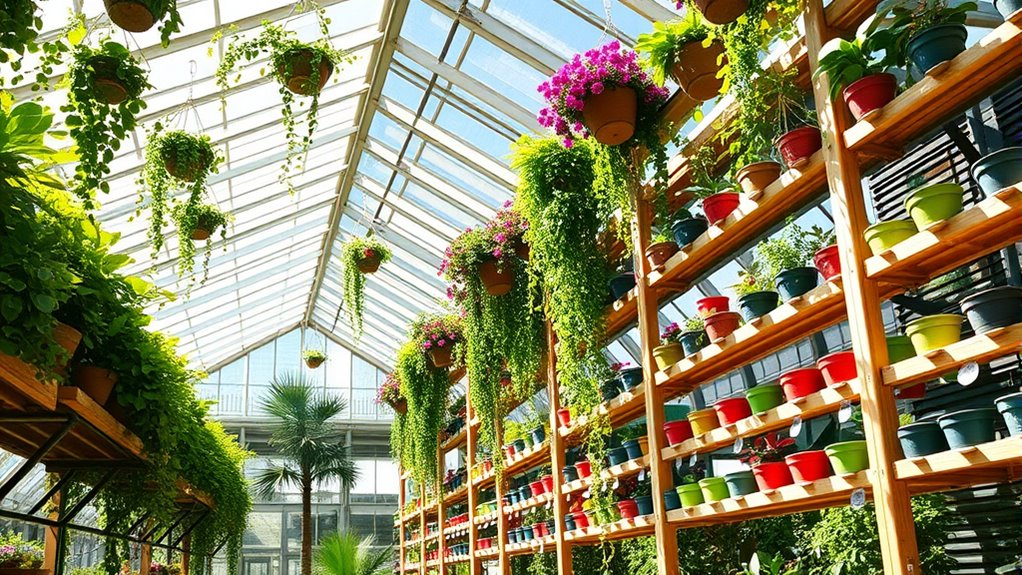
As you look to maximize space in your greenhouse, vertical growing techniques offer a smart solution for increasing your plant yield without expanding your footprint.
By utilizing walls, shelves, and other surfaces, you can grow plants upwards, enhancing crop yield and overall plant health. Choose climbing plants like tomatoes and cucumbers, or compact herbs such as basil and parsley for optimal results. Implement grow towers, hanging baskets, and trellises to make the most of your vertical space. These methods not only improve air circulation, reducing disease risk, but also create a visually appealing environment. Additionally, vertical gardening systems allow for greater plant variety in confined areas, further boosting your greenhouse productivity. Using unique and wicked planters can also add a creative touch to your vertical setup while ensuring your plants thrive.
Incorporating season extension techniques can also enhance your growing capabilities throughout the year. With consistent watering and proper lighting, your vertical garden can thrive, making the most of every inch in your greenhouse.
Optimizing Climate Control Systems
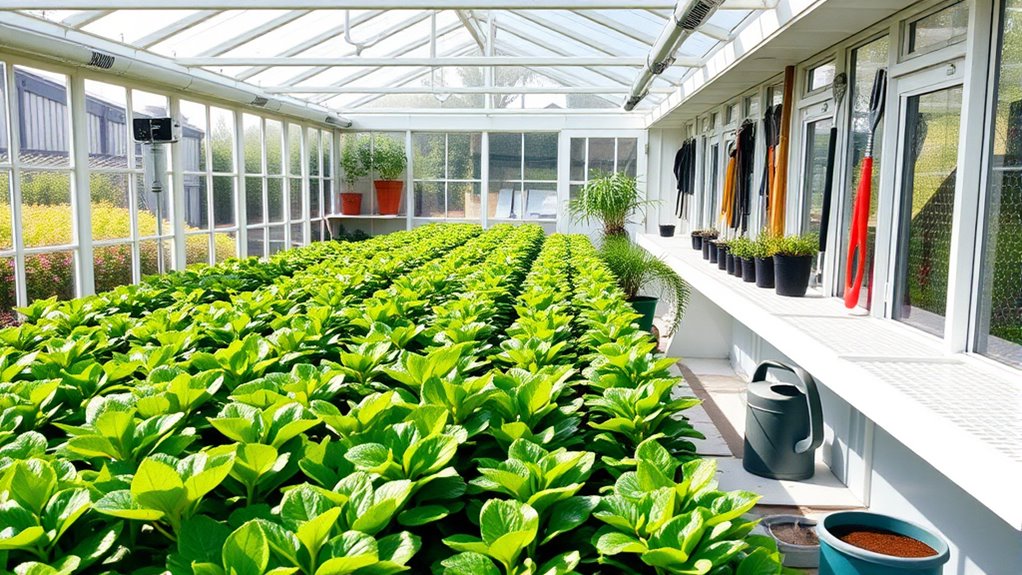
Maximizing vertical space in your greenhouse not only boosts plant yield but also highlights the importance of maintaining optimal growing conditions.
To achieve this, you'll want to optimize your climate control systems. Start by implementing temperature sensors to ensure stable conditions, preventing fluctuations that can stress your plants. Incorporating precision temperature sensors can further enhance your ability to eliminate temperature fluctuations.
Adjust humidity levels with dehumidification modes based on indoor and outdoor readings. Use environmental controls to manage light intensity, mimicking natural sunlight for better plant quality.
Automation can significantly cut energy costs, optimizing heating and cooling. Lastly, integrate forecasting features to proactively adjust settings based on anticipated weather changes.
Integrating Advanced Data Analytics for Decision Making
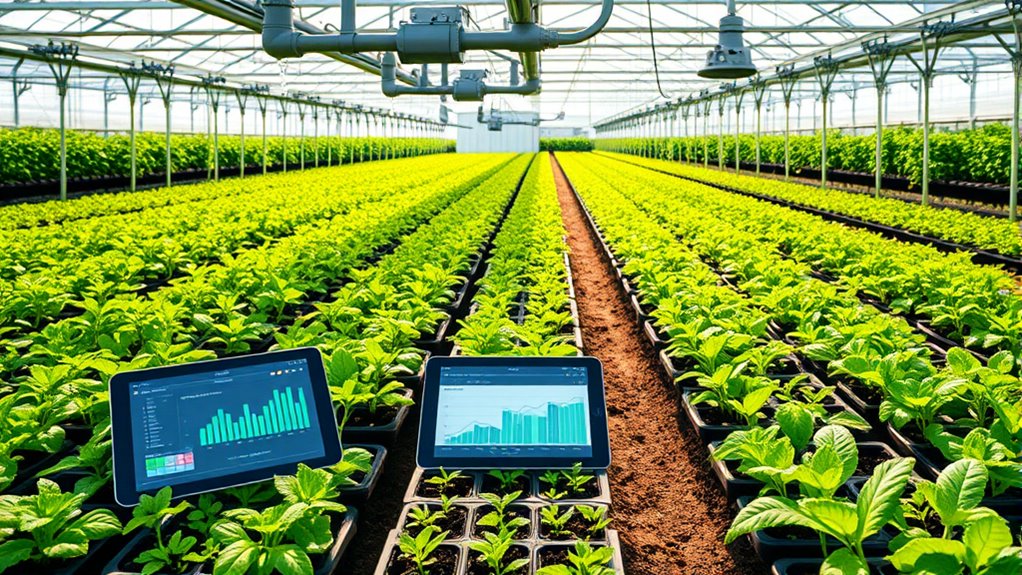
When it comes to greenhouse management, integrating advanced data analytics can transform your decision-making process. By utilizing machine learning algorithms, you can collect and analyze vast amounts of data on environmental conditions and plant growth. These algorithms identify patterns in historical data, allowing you to predict future crop yields and detect potential diseases early. Additionally, accurate forecasting is essential as it helps you navigate multiple uncertainties in production. Data preprocessing techniques like normalization and feature selection ensure that your analysis is effective. With AI integration, you can optimize resource allocation while simulating different scenarios for accurate yield forecasting. Leveraging data visualization tools helps you gain deeper insights, ensuring you make informed decisions promptly. Embracing advanced analytics not only enhances your operations but also maximizes your greenhouse's potential.
Streamlining Inventory Management Practices
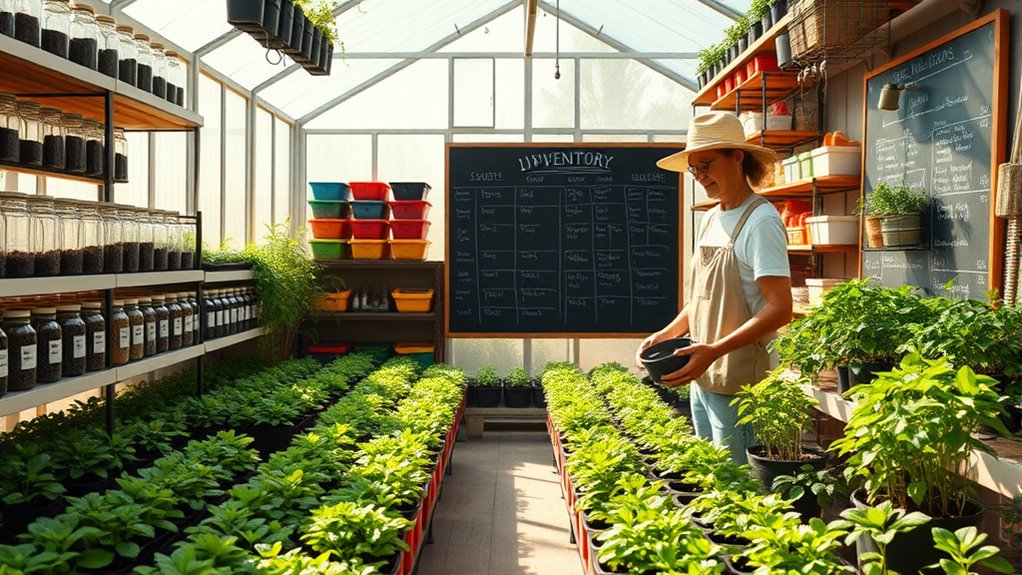
Integrating advanced data analytics into your greenhouse management not only enhances decision-making but also sets the stage for streamlined inventory management practices.
Start by analyzing your customer base to determine inventory needs, adjusting stock based on demand forecasting and seasonal variations. Implement real-time tracking systems to monitor stock levels and ensure timely restocking.
Classify inventory into categories—like plant material, equipment, and supplies—to manage efficiently. Regular inventory audits help identify discrepancies and maintain accuracy. Inventory management is critical for operational efficiency in commercial plant growing.
Utilize automated replenishment systems and set threshold alerts to prevent stockouts. By understanding sales trends and customer buying patterns, you can optimize inventory turnover and reduce waste, ultimately creating a more efficient operation that meets customer demands effectively.
Automating Operations for Consistency and Cost Savings
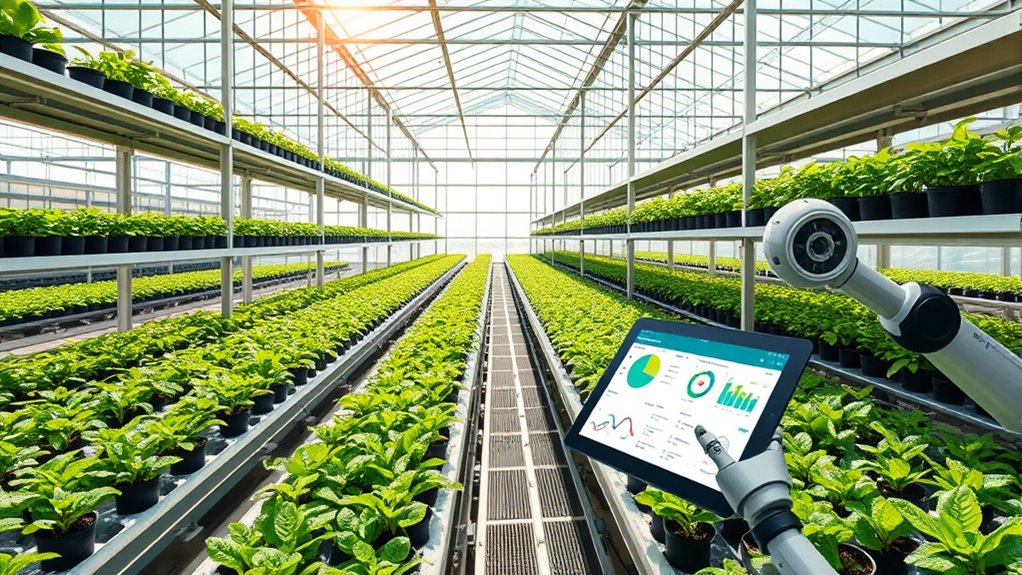
Automating operations in your greenhouse not only enhances consistency but also helps you save on costs, allowing you to focus on what truly matters—growing healthy plants.
With automated environmental controls, you can optimize temperature, humidity, and CO2 levels, promoting better growth. Automated irrigation systems ensure precise watering based on soil moisture, preventing waste and overwatering. Additionally, optimal growing conditions created by automation lead to healthier crops and increased resilience against external stressors.
Automated controls optimize your greenhouse conditions, ensuring precise watering and ideal growth for healthier plants.
By integrating advanced technology like sensors and cloud-based solutions, you gain real-time monitoring capabilities that enhance labor efficiency. This consistency leads to improved crop quality and yield while reducing labor costs.
Plus, automation minimizes environmental stress on your plants, creating ideal conditions year-round. Embrace automation to streamline your greenhouse operations and achieve sustainable growth.
Establishing Energy Efficiency Measures
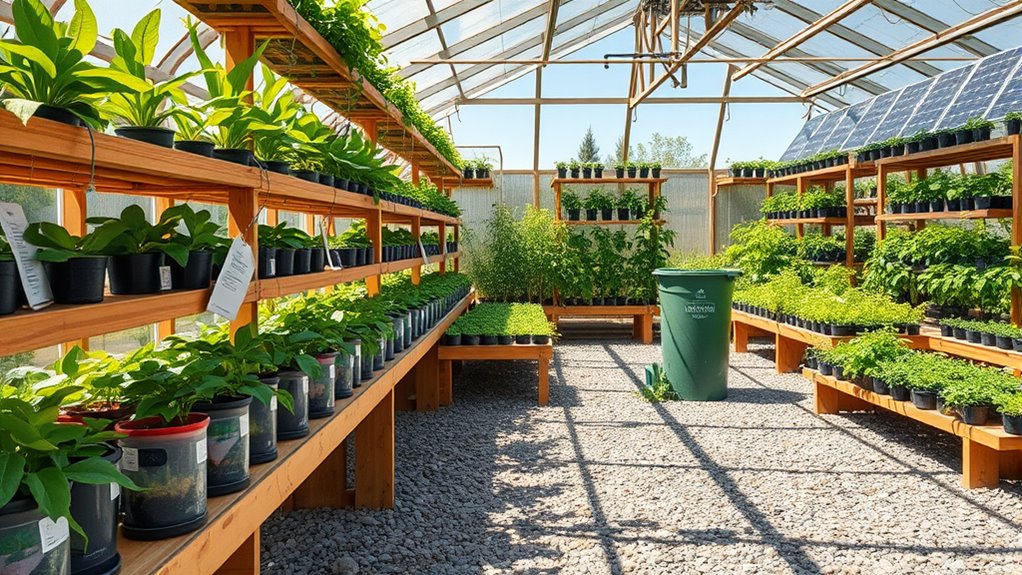
To establish energy efficiency measures in your greenhouse, it's crucial to assess your current practices and identify areas for improvement.
Start by conducting an energy audit to pinpoint inefficiencies. Consider utilizing renewable energy sources like solar panels or wind turbines to cut fossil fuel reliance, as transitioning to renewable energy sources enhances energy efficiency in greenhouse operations.
Enhance insulation and install thermal screens to maintain temperature, reducing heating and cooling demands. Implement efficient heating systems such as heat pumps or geothermal systems for better energy use.
Invest in automated ventilation and shading systems to control temperature and humidity effectively. Upgrade to LED lighting and use adaptive controls to optimize light usage.
Developing Sustainable Water Management Practices
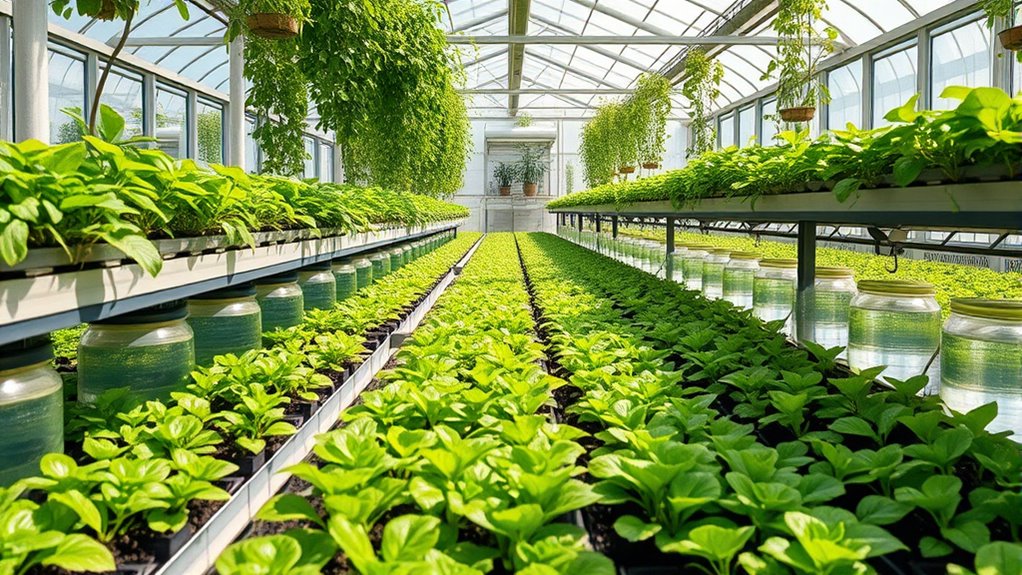
While managing water in your greenhouse, developing sustainable practices is essential for conserving resources and supporting plant health.
Start by harvesting rainwater from your roof to reduce reliance on external sources. Consider using ponds or cisterns for extra water storage, ensuring you maintain water quality with UV-resistant tanks. Water quality is a key challenge for alternative sources, so it's important to implement regular testing protocols. Implementing proper refrigerant management can also be beneficial for maintaining overall system efficiency. Additionally, utilizing seasoned wood for heating can further enhance the sustainability of your greenhouse environment. Incorporating solar energy solutions can also provide eco-friendly power for water management systems.
Implement gravity-fed systems for cost-effective distribution. Treat your water with aeration and filtering systems to improve quality and control pathogens.
Recycling water through recirculation and flood floor systems can significantly cut down on waste and enhance nutrient control.
Optimize irrigation with drip systems and soil moisture sensors to avoid overwatering.
Regularly monitor water quality and usage trends to refine your management practices and boost sustainability.
Frequently Asked Questions
How Can I Improve Employee Training for Greenhouse Operations?
To improve employee training for greenhouse operations, you can implement structured programs like "Tell, Show, Do, Review, and Teach."
Encourage shadowing experienced staff to foster hands-on learning.
Utilize digital tools for continuous training and performance tracking.
Offer leadership development workshops and feedback techniques to enhance communication.
Incorporate visual aids and printed protocols for clear guidance.
Lastly, create a supportive environment with professional development opportunities to keep employees engaged and motivated.
What Are the Best Practices for Greenhouse Pest Management?
Picture a thriving greenhouse, lush with vibrant plants, yet hidden pests threaten its beauty.
To manage these invaders, start by removing debris and inspecting incoming stock. Use sticky traps for early detection and quarantine infested plants.
Maintain a balanced environment with proper ventilation and irrigation. Introduce beneficial insects for natural control, and scout regularly to stay ahead.
Your vigilance today ensures a flourishing greenhouse tomorrow—where plants grow strong and pests stay at bay.
How Often Should I Conduct Greenhouse Maintenance Checks?
You should conduct greenhouse maintenance checks at least twice a year.
During these inspections, look for cracks in glazing, wear on frames, and signs of pests or diseases.
After extreme weather events, schedule additional checks to address any potential damage.
Regularly monitor your irrigation systems and environmental controls to ensure everything operates efficiently.
What Types of Plants Are Best Suited for Vertical Growing?
Did you know that vertical gardening can increase your yield by up to 50% compared to traditional methods?
For vertical growing, you'll love indeterminate tomatoes, vining cucumbers, and colorful pole beans. Snow and snap peas thrive on trellises, while smaller squash varieties, like acorn or zucchini, fit perfectly.
How Can I Effectively Manage Greenhouse Waste Disposal?
To effectively manage greenhouse waste disposal, focus on implementing composting and anaerobic digestion. These methods turn organic waste into valuable resources, like nutrient-rich compost or renewable energy.
Additionally, consider integrating closed-loop systems to recycle waste and minimize environmental impact. Regularly assess your waste reduction strategies and ensure compliance with local regulations.
This proactive approach not only enhances sustainability but also improves space utilization and supports healthier plant growth in your greenhouse.
Conclusion
By organizing your greenhouse for efficiency, you'll not only boost productivity but also save time and resources. You might worry that implementing these changes takes too much effort, but remember, small adjustments can lead to big results. With a little planning and the right strategies, you can create a more streamlined operation that maximizes your yields and minimizes waste. Embrace these improvements and watch your greenhouse thrive, making your gardening experience more enjoyable and rewarding.
